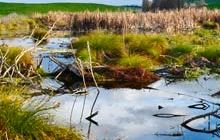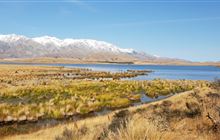Fernbird/mātātā
Introduction
These secretive wetland birds have disappeared from large areas of New Zealand, and populations continue to decline.New Zealand status: Endemic
Conservation status:
North Island and South Island forms are At Risk–Declining,
Stewart Island form is Threatened–Nationally Vulnerable,
Codfish Island and Snares Island forms are: At Risk–Naturally Uncommon,
Found in: The three main islands of New Zealand
Threats: Predation, habitat loss, human disturbance, roadkills
Species information: Fernbird on NZ Birds Online
Did you know?
Fernbirds are rarely seen because of their secretive behaviour and excellent camouflage.
Fernbird conservation
Fernbirds inhabit wetlands throughout New Zealand. They are a potential indicator of wetland health because they are dependent on the presence of high quality and ecologically diverse habitats and rich food supplies.
Population declines
Fernbirds have declined significantly since humans began draining wetlands. They are now classed globally as at risk, declining.
They have disappeared from large areas of New Zealand, including Wairarapa, Wellington and Canterbury.
Population estimates:
- ~1500 pairs estimated on Snares Islands (8 pairs/ha)
- 2.4 pairs/ha near Whangārei; 3 birds/ha at Tiropahi, West Coast
- 1.89 birds per 5-min count on Great Barrier Island
Many local populations have been lost due to drainage of wetlands and conversion to pasture, combined with predation by introduced mammal such as cats, rats, dogs and mustelids.
On Muttonbird Islands, several populations were wiped out by introduced ship rats (Solomon, Pukeweka and Big South Cape Islands), and by weka (Kundy and Jacky Lee Islands). The fernbirds on Great King and Aldermen Islands died out probably due to vegetation succession.
The translocation of fernbirds has led to some island populations being established or reestablished, eg North Island fernbirds to Tiritiri Matangi Island, Stewart Island fernbirds to Kundy Island, and Codfish Island fernbirds to Putauhinu Island.
Management tools
Wetlands support a wide range of threatened bird species in New Zealand. However, management techniques for restoring their populations are poorly developed.
DOC is focusing on developing methods for surveying fernbirds systematically. These methods will enable people to establish baseline data and distribution maps; identify important wetland habitat types for conservation and measure the response to management such as pest control; and habitat maintenance and restoration.
We have been developing ‘call counts’ for fernbirds. These take place with either an observer listening for set times at dawn or dusk using call lures, or with new automatic recorders (electronic recorders developed by the DOC Electronics Lab) recording calls remotely.
We are also actively developing methods for restoring wetlands through the Arawai Kākāriki Programme. At Awarua wetland in Southland, fernbird numbers have increased steadily since predator control commenced along the Tiwai Peninsula. A similar, but larger scale (c.3,500 ha) predator control programme has been started, aimed at increasing numbers of fernbirds and other wetland birds
You can help
Report sightings or calls of fernbird to your nearest DOC office.
Emergency hotline
Call 0800 DOC HOT (0800 362 468) immediately if you see anyone catching, harming or killing native wildlife.
On your property
- Trap predators on your property.
- Be a responsible cat owner.
In your community
- Find and volunteer with your local community group
- Trap predators in your community
- Get kids or schools involved
See Predator Free 2050 Trust - get involved for information.
Visiting parks, beaches, rivers, and lakes
- Leave nesting birds alone.
- Use available access ways to get to the beach.
- Avoid leaving old fishing lines in the water.
- Follow the water care code and local navigation bylaws.
- Do not drive on riverbeds, or keep to formed tracks if you have to.
- Check for pests if visiting pest-free islands.
With your dog
- Only take dogs to areas that allow them, and keep them under control.
- If you come across wildlife put your dog on a lead and lead it away.
- Warn other dog owners at the location.
- Notify DOC if you see wildlife being harassed by people or dogs.
- Get your dog trained in avian awareness.
- Learn about the Lead the Way programme which encourages dog owners to become wildlife wise and know how to act to protect coastal wildlife.
Specific ways to keep wildlife safe while with your dog on beaches.


